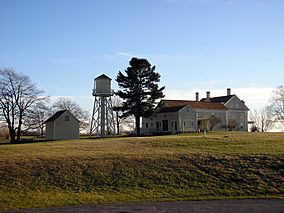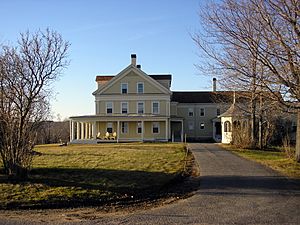Wells National Estuarine Research Reserve facts for kids
Quick facts for kids Wells National Estuarine Research Reserve |
|
|---|---|

Laudholm Farm buildings.
|
|
| Lua error in Module:Location_map at line 416: Malformed coordinates value. | |
| Location | Wells, Maine |
| Area | 2,250 acres (9.1 km2) |
| Established | 1984 |
The Wells National Estuarine Research Reserve is a special protected area in Wells, Maine, USA. It covers about 2,250 acres (9.1 km2) of land and water. Its main office is at a beautiful old farm called Laudholm.
This reserve helps us learn more about coasts and estuaries. Estuaries are places where rivers meet the sea. The Wells Reserve also teaches people about nature. It works with local communities to protect and restore coastal ecosystems. These are important natural areas around the Gulf of Maine. The reserve gets most of its money from the National Oceanic and Atmospheric Administration (NOAA) and a group called Laudholm Trust.
Contents
Exploring the Reserve
The Wells Reserve at Laudholm is open to everyone. You can visit every day from 7 AM until sunset. There are 7 miles (11 km) of trails to explore. These trails go through different natural areas. You will see woodlands, wetlands, and open grasslands. There are also salt marshes and sandy beaches. Some small areas are just for scientists.
The reserve protects three important estuaries. These are the Webhannet River estuary, the Little River estuary, and the Ogunquit River estuary. The Little River estuary gets its water from the Merriland River and Branch Brook. The land around the rivers includes one of southern Maine's biggest managed grasslands. You can also see old farm buildings. Most of these buildings are from the 1800s. They are listed on the National Register of Historic Places. This means they are very important historical sites.
Buildings and Facilities
The historic buildings at Laudholm Farm are used for many things. They help the Wells Reserve with its work.
The main farmhouse has a Visitor Center. Here, you can see exhibits about the reserve. It is open on weekdays and on weekends from Memorial Day to Columbus Day. This building also has offices for the staff. The old horse barn is used for special events and learning activities. It also stores equipment. The cow barn has a large room for talks and a library.
The Maine Coastal Ecology Center is a newer building. It opened in 2001. This center has a research lab where scientists work. It also has a teaching lab for students. There are more exhibits and offices here too.
The Alheim Commons is another building nearby. It has rooms where scientists, teachers, and land managers can stay. They use these rooms when they are working at the reserve or with its partners.
Research and Monitoring
Since the 1980s, the Wells Reserve has been studying coasts and estuaries. They want to learn more about these areas. A big part of their work is making sure salt marsh ecosystems are healthy. Some of the main things they study include:
- How fish are spread out and how they grow.
- How to bring salt marshes back to health.
- How land use near the coast affects the environment.
- Studying plants and animals that are not native and can cause harm (invasive species).
- How much life estuaries can support.
- Patterns in plant groups.
- How many birds are born and survive.
- The study of Lyme disease in nature.
Scientists at the reserve also keep track of weather, water quality, and nutrients. They watch plant and animal groups. This information helps a national effort to manage coastal areas well.
Education and Training
The Wells Reserve has educators who teach people about the environment. They teach both at the reserve and in local communities. Every year, over 3,000 kids and adults take part in learning programs. The reserve is like a living laboratory. It also has indoor places to help with teaching. Some of the learning programs include:
- School field trips.
- Training for teachers.
- Guided tours and special programs.
- Talks and workshops.
- Kits you can rent for learning activities.
- Backpacks with activities and trail guides.
- Summer day camps.
The Coastal Training Program is well-known across the country. It helps people who manage natural resources, politicians, and other leaders. It gives them information on how to manage coastal areas well. It also helps them work together on projects that protect rivers and their surrounding lands.
Conservation and Stewardship
Specialists at the Wells Reserve manage about 500 acres (2.0 km2) of land. This land has many different habitats. These habitats support a wide variety of plants and animals. The reserve is a great example of how to care for land. They use active ways to manage the land, such as:
- Controlling invasive plant species. These are plants that are not native and can harm the environment.
- Creating and keeping shrublands. These are areas with bushes that are good homes for wildlife.
- Protecting rare plants and animals that are in danger.
- Keeping fields open for birds that nest in grasslands.
- Managing the number of deer, as too many can harm the plants.
The Wells Reserve also helps communities protect nature. They offer mapping services and technical help. They also provide training and data. This information is useful for protecting land and water resources.
Protecting the Land
All the protected land of the Wells Reserve is in the town of Wells, Maine. Different groups own these conservation lands. The Maine Department of Conservation owns 533 acres. The United States Fish and Wildlife Service and Rachel Carson National Wildlife Refuge own 1,428 acres. The Town of Wells owns 249 acres. The Wells Reserve Management Authority owns 40 acres.
The Wells Reserve site, especially Laudholm Farm, has been farmed for over 300 years. It is a very important part of the town's history. The Laudholm Farm buildings show how farming changed in New England. By the 1970s, farming was no longer easy there. But the effort to protect Laudholm forever led to Maine's only National Estuarine Research Reserve being created. The farm buildings were fixed up and updated. This kept their history alive while making them useful for the reserve's research, education, and land care programs.
Images for kids




